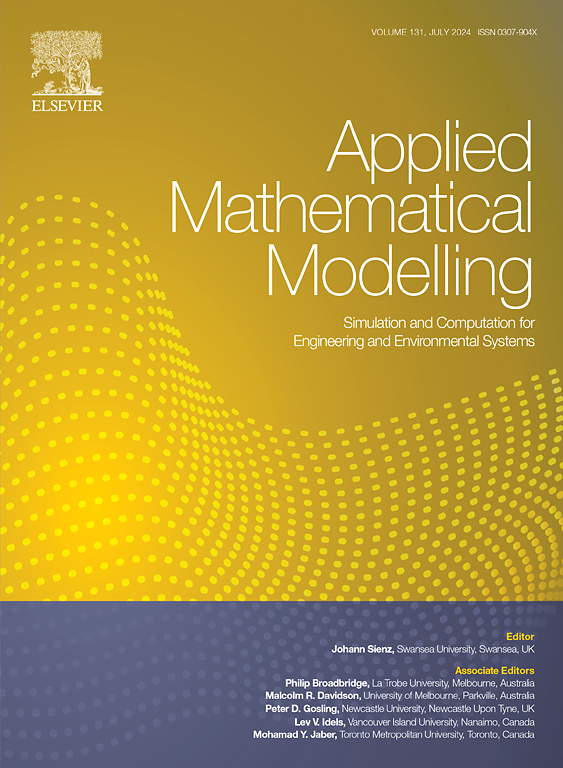Low frequency bandgap enhancement in dual graded metastructure beam with negative capacitance circuits and light-weight mass-spring resonators
IF 4.4
2区 工程技术
Q1 ENGINEERING, MULTIDISCIPLINARY
引用次数: 0
Abstract
In this work bandgap formation and vibration attenuation properties in graded metastructure beams are studied. By using negative capacitance circuits and different grading laws on frequency spacing and arrangement of the piezoelectric and mechanical resonators, hybrid graded metamaterial beams are formed. This study emphasizes the potential of spatially graded metamaterials as a promising solution for improving vibration attenuation in low-frequency applications. It is found that graded distribution of light-weight mechanical (<10 % mass of the host structure) and negative capacitance resonators, enhance the width of the bandgap especially at low frequency (lower than the first structural frequency). Moreover, the spatially graded resonators enhance vibration attenuation along the entire length of the beam, unlike the periodic configuration where suppression mainly occurs near the free end. It is also demonstrated that by tuning grading variation parameters in dual graded hybrid metamaterial beam, wide and effective attenuation bandgaps in desired positions can be achieved. To this end, the governing equations of the vibrations of hybrid meta-beams are derived using Hamilton principle. Initially, a Floquet solution is developed for the repetitive unit-cell of a periodic structure and its band structures are investigated through dispersion analysis. Then for the frequency response analysis, the governing equations are discretized using the Galerkin method and solved for various grading laws in mechanical, electromechanical, and dual graded meta-beams. Based on the obtained frequency response results, the bandgap properties of the meta-beams are analyzed and compared.
采用负电容电路和轻质量弹簧谐振器的双梯度元结构光束的低频带隙增强
本文研究了梯度元结构梁的带隙形成和振动衰减特性。利用负电容电路和压电谐振器与机械谐振器的不同频率间隔和排列规律,形成混合梯度超材料梁。这项研究强调了空间梯度超材料作为改善低频应用中振动衰减的有希望的解决方案的潜力。研究发现,轻量机械谐振器(占主体结构质量的10%)和负电容谐振器的梯度分布可以提高带隙宽度,特别是在低频(低于第一结构频率)。此外,空间梯度谐振器增强了沿整个光束长度的振动衰减,而不像周期性结构,抑制主要发生在自由端附近。通过调整双梯度混合材料光束的梯度变化参数,可以在期望位置获得宽而有效的衰减带隙。为此,利用哈密顿原理推导了混合梁振动的控制方程。首先,对周期结构的重复单元胞提出了Floquet解,并通过色散分析研究了其频带结构。然后利用伽辽金方法对控制方程进行离散化,求解了机械、机电和双级配梁的各种级配规律。根据得到的频率响应结果,分析和比较了元梁的带隙特性。
本文章由计算机程序翻译,如有差异,请以英文原文为准。
求助全文
约1分钟内获得全文
求助全文
来源期刊

Applied Mathematical Modelling
数学-工程:综合
CiteScore
9.80
自引率
8.00%
发文量
508
审稿时长
43 days
期刊介绍:
Applied Mathematical Modelling focuses on research related to the mathematical modelling of engineering and environmental processes, manufacturing, and industrial systems. A significant emerging area of research activity involves multiphysics processes, and contributions in this area are particularly encouraged.
This influential publication covers a wide spectrum of subjects including heat transfer, fluid mechanics, CFD, and transport phenomena; solid mechanics and mechanics of metals; electromagnets and MHD; reliability modelling and system optimization; finite volume, finite element, and boundary element procedures; modelling of inventory, industrial, manufacturing and logistics systems for viable decision making; civil engineering systems and structures; mineral and energy resources; relevant software engineering issues associated with CAD and CAE; and materials and metallurgical engineering.
Applied Mathematical Modelling is primarily interested in papers developing increased insights into real-world problems through novel mathematical modelling, novel applications or a combination of these. Papers employing existing numerical techniques must demonstrate sufficient novelty in the solution of practical problems. Papers on fuzzy logic in decision-making or purely financial mathematics are normally not considered. Research on fractional differential equations, bifurcation, and numerical methods needs to include practical examples. Population dynamics must solve realistic scenarios. Papers in the area of logistics and business modelling should demonstrate meaningful managerial insight. Submissions with no real-world application will not be considered.
 求助内容:
求助内容: 应助结果提醒方式:
应助结果提醒方式:


